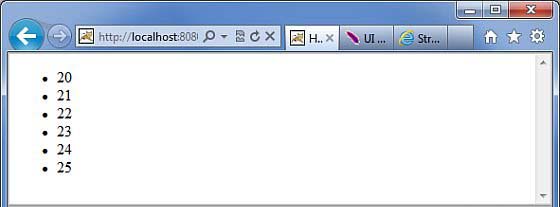bean標籤的設置和push 標籤的組合,它可以創建一個新的對象實例,然後設置變數的值。然後,它的bean可以在值棧,因此,它可用於在JSP頁面。
bean標籤需要一個Java Bean來工作。所以,標準的java bean規律應遵循。這是bean 應該有一個無參數的構造函數。要公開和使用的所有屬性的getter和setter 方法。對於這個練習的目的,讓我們用下麵的計數器類,在struts util包。Counter 類是一個bean,可以使用一個計數器來跟蹤。
因此,讓我們所有的檔保持不變,並修改的helloWorld.jsp檔。
創建動作類:
package com.zaixian.struts2; public class HelloWorldAction{ private String name; public String execute() throws Exception { return "success"; } public String getName() { return name; } public void setName(String name) { this.name = name; } }
創建視圖
讓我們包含以下內容 helloWorld.jsp:
<%@ page contentType="text/html; charset=UTF-8" %> <%@ taglib prefix="s" uri="/struts-tags" %> <html> <head> <title>Hello World</title> </head> <body> <s:bean name="org.apache.struts2.util.Counter" var="counter"> <s:param name="first" value="20"/> <s:param name="last" value="25" /> </s:bean> <ul> <s:iterator value="#counter"> <li><s:property /></li> </s:iterator> </ul> </body> </html>
接下來讓我們有employees.jsp包含以下內容:
<%@ page contentType="text/html; charset=UTF-8"%> <%@ taglib prefix="s" uri="/struts-tags"%> <html> <head> <title>Employees</title> </head> <body> <p>An example of the include tag: </p> <s:include value="HelloWorld.jsp"/> </body> </html>
配置檔
你的struts.xml應該像這樣:
<?xml version="1.0" encoding="UTF-8"?> <!DOCTYPE struts PUBLIC "-//Apache Software Foundation//DTD Struts Configuration 2.0//EN" "http://struts.apache.org/dtds/struts-2.0.dtd"> <struts> <constant name="struts.devMode" value="true" /> <package name="helloworld" extends="struts-default"> <action name="hello" class="com.zaixian.struts2.HelloWorldAction" method="execute"> <result name="success">/HelloWorld.jsp</result> </action> <action name="employee" class="com.zaixian.struts2.Employee" method="execute"> <result name="success">/employee.jsp</result> </action> </package> </struts>
web.xml中應該像這樣:
<?xml version="1.0" encoding="UTF-8"?> <web-app xmlns:xsi="http://www.w3.org/2001/XMLSchema-instance" xmlns="http://java.sun.com/xml/ns/javaee" xmlns:web="http://java.sun.com/xml/ns/javaee/web-app_2_5.xsd" xsi:schemaLocation="http://java.sun.com/xml/ns/javaee http://java.sun.com/xml/ns/javaee/web-app_3_0.xsd" id="WebApp_ID" version="3.0"> <display-name>Struts 2</display-name> <welcome-file-list> <welcome-file>index.jsp</welcome-file> </welcome-file-list> <filter> <filter-name>struts2</filter-name> <filter-class> org.apache.struts2.dispatcher.FilterDispatcher </filter-class> </filter> <filter-mapping> <filter-name>struts2</filter-name> <url-pattern>/*</url-pattern> </filter-mapping> </web-app>
右鍵點擊專案名稱,並單擊Export > WAR File創建一個WAR檔。然後部署此WAR在Tomcat的webapps目錄下。最後,啟動Tomcat伺服器和嘗試訪問URL http://localhost:8080/HelloWorldStruts2/hello.action。這會給出以下畫面:

在這個例子中,我們實例化一個新的org.apache.struts2.util.Counter bean實例。然後我們的第一個屬性設置為20和25最後一個屬性。這意味著計數器的值分別為20,21,22,23,24和25。我們給一個名為“Counter”的bean。 struts的bean標籤將bean實例化,並把它值棧中的。現在我們可以使用迭代器去,通過計數器bean的nd列印出計數器的值。.
上一篇:
Struts2 include標籤
下一篇:
Struts2快速入門
